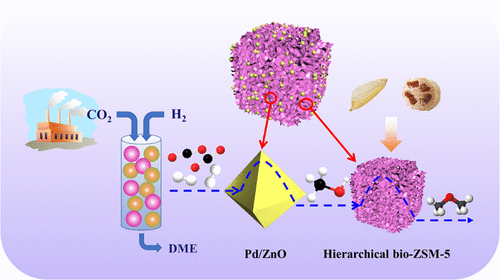当前位置:
X-MOL 学术
›
ACS Sustain. Chem. Eng.
›
论文详情
Our official English website, www.x-mol.net, welcomes your
feedback! (Note: you will need to create a separate account there.)
Hydrogenation of CO2 to Dimethyl Ether over Tandem Catalysts Based on Biotemplated Hierarchical ZSM-5 and Pd/ZnO
ACS Sustainable Chemistry & Engineering ( IF 7.1 ) Pub Date : 2020-08-28 , DOI: 10.1021/acssuschemeng.0c04399 Wen Li 1 , Kuncan Wang 2 , Guowu Zhan 3 , Jiale Huang 2 , Qingbiao Li 1, 2, 4
ACS Sustainable Chemistry & Engineering ( IF 7.1 ) Pub Date : 2020-08-28 , DOI: 10.1021/acssuschemeng.0c04399 Wen Li 1 , Kuncan Wang 2 , Guowu Zhan 3 , Jiale Huang 2 , Qingbiao Li 1, 2, 4
Affiliation

|
The chemical transformation of CO2 to value-added chemicals and fuels remains a daunting research challenge, requiring the development of more efficient catalysts. The present work offers highly active integrated nanocatalysts for CO2 hydrogenation to dimethyl ether (DME) through tandem catalysis, that is, Pd/ZnO converts CO2 to methanol, and bio-ZSM-5 further catalyzes methanol dehydration to DME. Notably, the hierarchically porous bio-ZSM-5 with high pore connectivity was prepared by using low-cost rice husk and luffa sponge as biotemplates. The formation of bio-ZSM-5 involved three consecutive steps, including (i) diffusion of precursor species, (ii) confined crystal growth, and (iii) calcination treatment to remove the residual biomass. Interestingly, the obtained bio-ZSM-5 possesses abundant hierarchical porosity, including the intrinsic micropores from ZSM-5 frameworks, the mesopores from intracrystalline void space or pinholes in the intergrown zeolite layers, and the macroscopic channels from the original biomass architecture. It was found that the tetrapropylammonium hydroxide amount and Si/Al ratio were two critical factors affecting the crystallinity and porosity of the bio-ZSM-5. The silicon content in biomass (8.3 wt % in rice husk and 0.016 wt % in luffa sponge) also played a crucial role in the synthesis of bio-ZSM-5. Different spatial configurations of Pd/ZnO and bio-ZSM-5 significantly affected the DME yield, wherein spatial distances between the bio-ZSM-5 and Pd/ZnO components were adjusted by controlling the size of Pd/ZnO or the integration manners. The current results indicated that the closest proximity of the bifunctional catalyst was unfavorable for DME production (selectivity < 3%), because of which low-valent Zn cations from Pd/ZnO could displace the Brønsted acid sites on bio-ZSM-5 by ion exchange, and the powder mixing in the mortar was the best combination configuration of Pd/ZnO and bio-ZSM-5, promoting the CO2 conversion (10.8%) with a DME selectivity of 31% under the reaction of 300 °C and 30 bar. Furthermore, as compared to the traditional ZSM-5 based catalyst, the obtained Pd/ZnO/bio-ZSM-5 bifunctional catalysts showed excellent long-term stability in 60 h on stream with a less amount of coke formed in the spent catalysts.
中文翻译:

基于生物模板层次ZSM-5和Pd / ZnO的串联催化剂上CO 2加氢制二甲醚
从CO 2到增值化学品和燃料的化学转化仍然是艰巨的研究挑战,需要开发更高效的催化剂。本工作为通过串联催化将CO 2加氢成二甲醚(DME)提供了高活性的集成纳米催化剂,即Pd / ZnO可以转化CO 2到甲醇中,bio-ZSM-5进一步催化甲醇脱水成二甲醚。值得注意的是,通过使用低成本稻壳和丝瓜海绵作为生物模板制备了具有高孔隙连通性的分层多孔生物ZSM-5。生物ZSM-5的形成涉及三个连续步骤,包括(i)前驱物种类的扩散,(ii)有限的晶体生长和(iii)煅烧处理以去除残留的生物质。有趣的是,获得的生物ZSM-5具有丰富的分层孔隙度,包括来自ZSM-5骨架的固有微孔,来自晶体内空隙空间的中孔或共生沸石层中的针孔,以及来自原始生物质结构的宏观通道。发现氢氧化四丙基铵的量和Si / Al比是影响bio-ZSM-5的结晶度和孔隙率的两个关键因素。生物量中的硅含量(稻壳中为8.3 wt%,丝瓜海绵中为0.016 wt%)在生物ZSM-5的合成中也起着至关重要的作用。Pd / ZnO和bio-ZSM-5的不同空间构型显着影响DME的产量,其中bio-ZSM-5与Pd / ZnO组分之间的空间距离可通过控制Pd / ZnO的大小或积分方式来调节。目前的结果表明,双功能催化剂的最接近位置不利于DME的生产(选择性<3%),因为Pd / ZnO中的低价Zn阳离子可通过离子置换bio-ZSM-5上的布朗斯台德酸位交换,在300°C和30 bar的反应下,DME选择性为31%的2转化率(10.8%)。此外,与传统的基于ZSM-5的催化剂相比,所获得的Pd / ZnO / bio-ZSM-5双功能催化剂在运行60小时内表现出优异的长期稳定性,并且在废催化剂中形成的焦炭量更少。
更新日期:2020-09-21
中文翻译:

基于生物模板层次ZSM-5和Pd / ZnO的串联催化剂上CO 2加氢制二甲醚
从CO 2到增值化学品和燃料的化学转化仍然是艰巨的研究挑战,需要开发更高效的催化剂。本工作为通过串联催化将CO 2加氢成二甲醚(DME)提供了高活性的集成纳米催化剂,即Pd / ZnO可以转化CO 2到甲醇中,bio-ZSM-5进一步催化甲醇脱水成二甲醚。值得注意的是,通过使用低成本稻壳和丝瓜海绵作为生物模板制备了具有高孔隙连通性的分层多孔生物ZSM-5。生物ZSM-5的形成涉及三个连续步骤,包括(i)前驱物种类的扩散,(ii)有限的晶体生长和(iii)煅烧处理以去除残留的生物质。有趣的是,获得的生物ZSM-5具有丰富的分层孔隙度,包括来自ZSM-5骨架的固有微孔,来自晶体内空隙空间的中孔或共生沸石层中的针孔,以及来自原始生物质结构的宏观通道。发现氢氧化四丙基铵的量和Si / Al比是影响bio-ZSM-5的结晶度和孔隙率的两个关键因素。生物量中的硅含量(稻壳中为8.3 wt%,丝瓜海绵中为0.016 wt%)在生物ZSM-5的合成中也起着至关重要的作用。Pd / ZnO和bio-ZSM-5的不同空间构型显着影响DME的产量,其中bio-ZSM-5与Pd / ZnO组分之间的空间距离可通过控制Pd / ZnO的大小或积分方式来调节。目前的结果表明,双功能催化剂的最接近位置不利于DME的生产(选择性<3%),因为Pd / ZnO中的低价Zn阳离子可通过离子置换bio-ZSM-5上的布朗斯台德酸位交换,在300°C和30 bar的反应下,DME选择性为31%的2转化率(10.8%)。此外,与传统的基于ZSM-5的催化剂相比,所获得的Pd / ZnO / bio-ZSM-5双功能催化剂在运行60小时内表现出优异的长期稳定性,并且在废催化剂中形成的焦炭量更少。











































 京公网安备 11010802027423号
京公网安备 11010802027423号